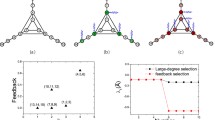Abstract
One of the fundamental problems in pinning control of complex networks is selecting appropriate pinning nodes, such that the whole system is controlled. This is particularly useful for complex networks with huge numbers of nodes. Recent research has yielded several pinning node selection strategies, which may be efficient. However, selecting a set of pinning nodes and identifying the nodes that should be selected first remain challenging problems. In this paper, we present a network control strategy based on left Perron vector. For directed networks where nodes have the same in- and out-degrees, there has so far been no effective pinning node selection strategy, but our method can find suitable nodes. Likewise, our method also performs well for undirected networks where the nodes have the same degree. In addition, we can derive the minimum set of pinning nodes and the order in which they should be selected for given coupling strengths. Our proofs of these results depend on the properties of non-negative matrices and M-matrices. Several examples show that this strategy can effectively select appropriate pinning nodes, and that it can achieve better results for both directed and undirected networks.
Similar content being viewed by others
References
X. F. Wang, and G. Chen. Pinning control of scale-free dynamical networks. Phys A, 2002, 310: 281–302
Chen T, Liu X, Lu W. Pinning complex networks by a single controller. IEEE Trans Circuits Syst I, 2007, 54: 1317–1326
Zhou J, Lu J, Lü J. Pinning adaptive synchronization of a general complex dynamical network. Automatica, 2008, 44: 996–1003
Zhou J, Lu J, Lü J. Erratum to: Pinning adaptive synchronization of a general complex dynamical network. [Automatica 44 (2008) 996–1003]. Automatica, 2009, 45: 598–599
Sun W, Lü J, Chen S, et al. Pinning impulsive control algorithms for complex network. Chaos, 2014, 24: 013141
Wang P, Lü J, Yu X. Identification of important nodes in directed biological networks: A network motif approach. PLoS ONE, 2014, 9: e106132
Jalili M, Askari Sichani O, Yu X. Optimal pinning controllability of complex networks: Dependence on network structure. Phys Rev E, 2015, 91: 012803
Li X, Wang X, Chen G. Pinning a complex dynamical network to its equilibrium. IEEE Trans Circuits Syst I, 2004, 51: 2074–2087
Yu W, Chen G, Lü J. On pinning synchronization of complex dynamical networks. Automatica, 2009, 45: 429–435
Lu J Q, Ho D W, Wang Z D. Pinning stabilization of linearly coupled stochastic neural networks via minimum number of controllers. IEEE Trans Neural Netw, 2009, 20: 1617–1629
Xiong W, Ho D W C, Huang C. Pinning synchronization of timevarying polytopic directed stochastic networks. Phys Lett A, 2010, 374: 439–447
Liu H, Xie G, Wang L. Containment of linear multi-agent systems under general interaction topologies. Syst Control Lett, 2012, 61: 528–534
DeLellis P, Garofalo F, Lo Iudice F. The partial pinning control strategy for large complex networks. Automatica, 2018, 89: 111–116
Liu Y, Li B, Lu J, et al. Pinning control for the disturbance decoupling problem of boolean networks. IEEE Trans Automat Contr, 2017, 62: 6595–6601
Sanchez E N, Rodriguez-Castellanos D I, Chen G, et al. Pinning control of complex network synchronization: A recurrent neural network approach. Int J Control Autom Syst, 2017, 15: 1405–1414
Song Q, Liu F, Cao J, et al. M-matrix strategies for pinning-controlled leader-following consensus in multiagent systems with nonlinear dynamics. IEEE Trans Cybern, 2013, 43: 1688–1697
Song Q, Cao J. On pinning synchronization of directed and undirected complex dynamical networks. IEEE Trans Circuits Syst I, 2010, 57: 672–680
Zhang F. Matrix Theory: Basic Results and Techniques. New York: Springer, 2011
Horn R A, Johnson C R. Topics in Matrix Analysis. Cambridge: Cambridge University Press, 1991
Berman A, Plemmons R J. Nonnegative Matrices in the Mathematical Sciences. Philadelphia: SIAM, 1994
Song Q, Liu F, Cao J, et al. Pinning-controllability analysis of complex networks: An M-matrix approach. IEEE Trans Circuits Syst I, 2012, 59: 2692–2701
Author information
Authors and Affiliations
Corresponding author
Rights and permissions
About this article
Cite this article
Cheng, Z., Xin, Y., Cao, J. et al. Selecting pinning nodes to control complex networked systems. Sci. China Technol. Sci. 61, 1537–1545 (2018). https://doi.org/10.1007/s11431-018-9319-4
Received:
Accepted:
Published:
Issue Date:
DOI: https://doi.org/10.1007/s11431-018-9319-4




